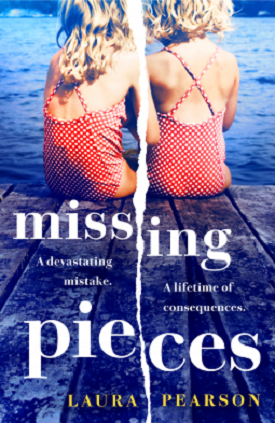 Synopsis:
Synopsis:
What if the one thing that kept you together was breaking you apart? How can you repair something broken if pieces are missing?
All Linda wants to do is sleep. She won’t look at her husband, Tom. She can’t stand Esme, her seven-year-old daughter. And she doesn’t want to have the baby she is carrying. Because having the baby means moving on with life following an unspeakable tragedy. Linda just wants life to return to the way it was before. Before their hearts were shattered, before their family was torn apart, before blame was placed.
Alienated by guilt, the Sadler family struggles to cope, but unravels. The girls grow up. Family members grow apart. They never talk about the past or the terrible secret until Bea — the baby Linda did not want to deliver — now in her twenties, learns that she is pregnant.
Before she brings another child into the world, Bea needs to know what happened twenty-five years ago. What information did her family keep from her? What happened that couldn’t be fixed? What devastating mistake resulted in a lifetime of consequences?
Review:

It soon becomes clear that Phoebe was Linda and Tom’s three-year-old daughter, and they, along with seven-year-old Esme, have sustained the must unimaginable loss. Each of them responds to the tragedy in his/her unique way. A part of little Esme has been lost along with her younger sister. She carries the weight of what has happened, even though she is too young to fully comprehend the tragedy, much less her role in it or its impact upon her family. Tom attempts valiantly to hold his family together, even though he carries guilt as a result of his own reaction to the chasm that had broken open in his marriage to Linda even before Phoebe’s death. He encourages Linda to carry on for the sake of their two surviving daughters, who deserve to be loved, cherished, and protected. As he looks as newborn Bea, he longs to tell Linda, “I know what we’ve lost and it’s killing me too, but look at what we have. You’re missing it.” Why doesn’t he?
But Pearson’s focus is upon Linda and her crippling grief, guilt, and anger. Pearson realistically crafts a heartbreaking portrait of a woman who is undone and utterly unable to function. It is not easy, but devastatingly compelling reading.
And then Pearson moves the story forward twenty-five years. Bea has moved away from home and been largely estranged from Tom and Esme. She has not seen either of them for a year, and is in a dead-end relationship with a man who is neither equipped nor ready to be a father. But she is indeed pregnant and must decide whether to carry the baby to term. Bea is the only member of the family with no memory of Phoebe upon which to draw. In fact, she has never been told how Phoebe died, much less any of the details about how her family coped in the horrible days following Phoebe’s death. As a result, she has always felt like an outsider in her own family, “never understanding why they wouldn’t — or couldn’t — let her in.” She resolves to go home for a visit and learn the truth so that she can understood her family’s history and move forward with her own life.
Everyone in her family had made small, understandable mistakes that day and those mistakes had come together to create something dreadful, something none of them had ever got over. . . . And that’s what they represented, of course. A lifetime of darkness.
Esme, now thirty-two, has never married, continues living at home with Tom, and assists him with the operation of his bookstore. She channels her energy into jogging, running for the “sensation of being alive,” running “away from the pain and guilt” she has carried since she was a young child. She has never confronted her own emotions about the loss of Phoebe. But she agrees with Bea that the time has come and sets about telling Bea what happened through a series of confessional letters addressed to Phoebe. As with her description of Linda’s reaction to losing Phoebe, Pearson pulls readers into Esme’s psyche in a convincing, emotionally raw manner. It is an authentic exploration by a young woman who needs to forge a life for herself before it is too late of the events that transpired when she was but a child. In the process, not only is the relationship of the two sisters, Esme and Bea, transformed, but both daughters also confront their reaction to revelations about Tom’s behavior and their parents’ marriage, as well as the details of their mother’s suffering and fate. Things begin to change in the Sadler family. Secrets are revealed, difficult conversations had.
Missing Pieces is a stunning debut work, featuring characters with whom readers will readily relate. Pearson reveals the details about the Sadler family history at expertly-timed intervals that keep the action moving and sustain interest. She deftly explores the characters’ responses to the sudden tragic death of a young child with compassion, credibility, and depth, sans melodrama or plot contrivance.
Missing Pieces is a beautifully crafted story about a family struggling to survive an unthinkable event. There are no villains in this story, but Pearson explores each characters’ believable strengths and flaws in a manner that makes the characters increasingly empathetic as the truth is gradually revealed. When the full story of the tragic day when they lost Phoebe is finally told, the characters’ catharses ring true, as does their newfound appreciation of their own strength, resiliency, and capacity to forgive — and the hope for their futures that Pearson injects into their story.
My reviews of Laura Pearson’s other books:
Guest posts by Laura Pearson:
- (Some of) the Books that Shaped Me
- Sending Your Second Novel into the World
- On Surviving and Writing Cancer



Comments are closed.